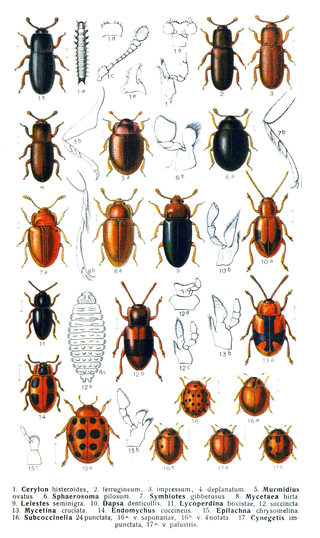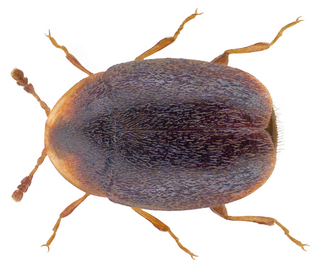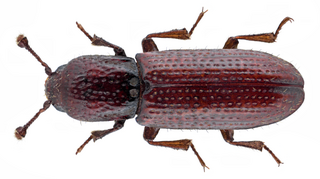
Cucujoidea is a superfamily of beetles. This group formerly included all of the families now included in the superfamily Coccinelloidea. They include some fungus beetles and a diversity of lineages of "bark beetles" unrelated to the "true" bark beetles (Scolytinae), which are weevils.

Corylophidae is a family of minute hooded beetles, sometimes called minute fungus beetles, in the superfamily Coccinelloidea. There are about 18 genera and at least 120 described species in Corylophidae. They feed on microfungi such as molds, and are often found associated with bark, as well as in leaf litter and other decaying vegetation. In older literature, the family name was often given as Orthoperidae.

Endomychidae, or handsome fungus beetles, is a family of beetles with representatives found in all biogeographic realms. There are around 120 genera and 1300 species. The family was established based on the type genus Endomychus, a genus erected in 1795 by Panzer which was applied to a species that Linnaeus called Chrysomela coccinea. As the common name suggests, Endomychidae feed on fungi. Crowson, in his influential treatment of the beetles, placed the family within the Cucujoidea. They have a tarsal formal of 4-4-4 or 3-3-3 and the wings lack a closed radial cell. The second antennal segment has a sensory appendage that is as long as the third antennal segment. The family has also been grouped with the Coccinellidae in a group called the Trimera for having pseudotrimerous tarsi. A 2015 molecular phylogeny study found that the Cucujoidea were found to be non-monophyletic and the Endomychidae was refined with the removal of the Anamorphinae from within the family and elevated to the status of a full family, Anamorphidae. Mycetaeinae and Eupsilobiinae were also found not to belong within the clades of the core Endomychidae, and likewise reclassified into the families Mycetaeidae and Eupsilobiidae.

Bothrideridae is a family of beetles in the superfamily Coccinelloidea. They are known commonly as the cocoon-forming beetles or dry bark beetles. They occur worldwide with most native to the Old World tropics. In older literature, the family was often included in the family Colydiidae, but is now considered unrelated.
Epipocus gorhami is a species of handsome fungus beetle in the family Endomychidae. It is found in Central America and North America.

Coccinelloidea is a superfamily of beetles in the order Coleoptera, formerly included in the superfamily Cucujoidea. There are more than 10,000 species in Coccinelloidea, including more than 6000 in the lady beetle family Coccinellidae.
Holopsis is a genus of minute hooded beetles in the family Corylophidae. There are about 9 described species in Holopsis.

Teredidae is a family of beetles in the superfamily Coccinelloidea, formerly included within the family Bothrideridae. There are around 160 species in 10 genera, found worldwide except South America. Teredids are generally found under bark, in the galleries of wood-boring beetles, or in leaf litter. They are thought to be fungivores. The oldest records of the family are Delteredolaemus from mid-Cretaceous aged Burmese amber from Myanmar and a species of Teredolaemus from Eocene aged Baltic amber.

Euxestidae is a family of beetles in the superfamily Coccinelloidea, formerly included within the family Cerylonidae. They are around 70 extant species in 10 genera, distributed primarily in the tropical and subtropical regions of Afro-Eurasia. They are found in decomposing wood, leaf litter, ant nests, and the fungus gardens of termites. All species are presumed to be mycophagous.

Murmidiidae is a family of beetles in the superfamily Coccinelloidea, formerly included within the family Cerylonidae. The family contains thirty-four described species in four genera, which are found worldwide. They are typically found under the bark of recently dead trees, and are thought to be mycophagous. The species Murmidius ovalis, found worldwide, is noted as a pest of stored food.

Anamorphidae is a family of beetles in the superfamily Coccinelloidea, formerly included within the family Endomychidae. They are found worldwide. Like enchomyids, they are fungivores, with adult and larval stages thought to exclusively consume fungal spores.

Mycetaeidae is a family of beetles in the superfamily Coccinelloidea, formerly included within the family Endomychidae. There are two genera currently included in the family, Agaricophilus and Mycetaea, which are morphologically divergent from each other, and it is unclear whether they are closely related. Mycetaea is found in North America, Europe and South Africa, while Agaricophilus is restricted to Europe. While the life history of Agaricophilus is obscure, Mycetaea is known to be mycophagous, feeding on molds.

Artematopodidae is a family of soft-bodied plant beetles in the superfamily Elateroidea. They are mostly found in understory forest foliage. The life history of the group is obscure, larvae of the genera Eurypogon and Macropogon likely feed on moss, while the larvae of Artematopus have been fed insect remains. The oldest fossils of the family date to the Middle Jurassic.

Trochoideus desjardinsi is a species of handsome fungus beetle in the family Endomychidae. It is found in Africa, North America, and Southern Asia.

Trochoideus is a genus of handsome fungus beetles in the family Endomychidae. There are about 10 described species in Trochoideus.
Bystus is a genus of beetles in the family Anamorphidae. There are about six described species in Bystus.
Rhymbomicrus is a genus of beetles in the family Anamorphidae. There are at least four described species in Rhymbomicrus.

Merophysiinae is a subfamily of handsome fungus beetles in the family Endomychidae.
Micropsephodes is a genus of beetles in the family Anamorphidae. There are at least two described species in Micropsephodes.

Myrabolia is the only genus in the beetle family Myraboliidae in the superfamily Cucujoidea. It has about 13 species, found in Australia. Adults and possibly larvae live under the bark of Eucalyptus trees.














